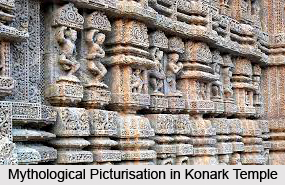 The legends of Konark temple in Orissa narrate the tales of Samba Purana, the son of Lord Krishna by one of his numerous wives named Jambavati. He was stricken with leprosy, as he had unwittingly incurred the displeasure of his irate father for having been found loitering listlessly about the bathing-place of his father`s wives. He was advised to repair to the Maitravana on the river Chandrabhaga to get rid of his sufferings by austere penance in the worship of the Sun. The Sun had been worshipped in India from the earliest antiquity not only as the great source of light but also as the great healer of incurable diseases. Numerous temples, dedicated to the Sun, existed all over India, and the Maitravana appears from this Puranic account to have acquired a special celebrity. Pilgrims still resort to it once a year in the month of Magh.
The legends of Konark temple in Orissa narrate the tales of Samba Purana, the son of Lord Krishna by one of his numerous wives named Jambavati. He was stricken with leprosy, as he had unwittingly incurred the displeasure of his irate father for having been found loitering listlessly about the bathing-place of his father`s wives. He was advised to repair to the Maitravana on the river Chandrabhaga to get rid of his sufferings by austere penance in the worship of the Sun. The Sun had been worshipped in India from the earliest antiquity not only as the great source of light but also as the great healer of incurable diseases. Numerous temples, dedicated to the Sun, existed all over India, and the Maitravana appears from this Puranic account to have acquired a special celebrity. Pilgrims still resort to it once a year in the month of Magh.
The worship of a sacred tree came also to be associated with this place, and we have a reference to it in the Kapila samhita. Konark appears, therefore, to have given shelter to Buddhism, when that faith prevailed in all parts of Orissa. The Black Pagoda or Konark temple might, thus, have been built with older materials during the restoration of Sun worship after it had been temporarily superseded by Buddhism. The twenty-eight temples, said to have performed miracles, are no longer in existence. It would be interesting to know what faith used to be represented by them.
Some of the local legends say that King Narasimha Deva-I of the Ganga Dynasty had initiated the construction of the Black Pagoda. It is said that he wanted to build the temple as an epitome of his political supremacy. The legend also has that around 1200 architects and artisans had worked for a period of continuous 12 long years to build the temple.
Today it is generally described by the priests as one of the four Kshetras or holy places of Orissa, where Lord Vishnu left his weapons in his conflict with the great demon Gaya. According to this legend, Puri is the Sankha Kshetra where the conch shell was left; Jajpur District is the Gada Kshetra, where the club was left; Bhuvaneshwar is the Chakra Kshetra, where the discus was left; and Konark is the Padma Kshetra, where the lotus was left. But Konark had yet another name, which is scarcely remembered now. It was called the Maitra vana.











